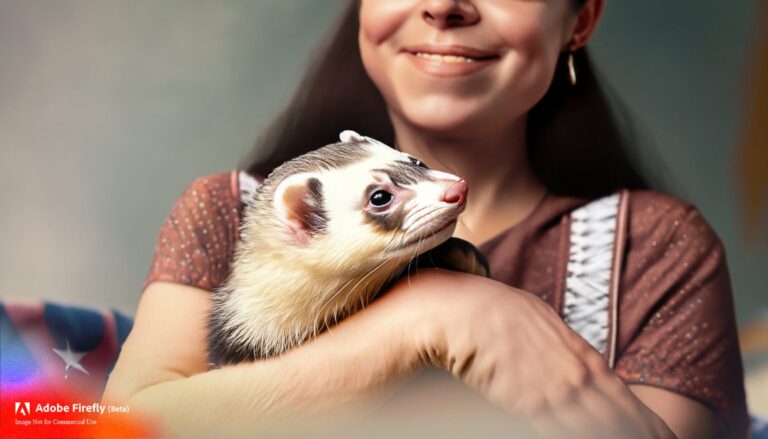
Ferrets are fascinating and playful creatures that make wonderful pets. If you’re considering adding a ferret to your family, it’s important to understand the differences between male and female ferrets. From their physical characteristics to their behavior, knowing what sets them apart will help you provide the best care for your furry friend.
Male ferrets, also known as hobs, have a larger and more muscular build compared to their female counterparts. They also tend to have a stronger odor, which can be managed with proper hygiene and regular cleaning. On the other hand, female ferrets, known as jills, are typically smaller in size and have a more slender frame. Understanding these physical distinctions can help you choose the right ferret that fits your lifestyle and preferences.
In addition to their physical differences, male and female ferrets also exhibit distinct behaviors. Male ferrets are generally more active and playful, often engaging in rougher play with their toys or fellow ferrets. Female ferrets, on the other hand, tend to be more independent and may display a slightly calmer demeanor. Knowing these behavior traits will help you create a stimulating and enriching environment for your ferret, allowing them to thrive and be happy companions.
Understanding the differences between male and female ferrets is crucial when considering them as pets. From their physical attributes to their behavior, these distinctions will guide you in providing the best care and companionship for your furry friend. So, whether you choose a playful hob or an independent jill, you’re sure to have a delightful and rewarding experience with your ferret companion.
Key Takeaways
- Male ferrets, known as hobs, are larger and more muscular than female ferrets, known as jills.
- Hobs tend to have a stronger odor, which can be managed with proper hygiene and regular cleaning.
- Male ferrets are generally more active and playful, while female ferrets may be more independent and have a calmer demeanor.
- Understanding the physical and behavioral differences between male and female ferrets is important for providing the best care and companionship.
- To manage the odor of male ferrets, consider neutering, regular cage cleaning, using odor-neutralizing products, and occasional bathing.
- When choosing a ferret, consider their size, build, physical appearance, and personality to ensure a good fit for your lifestyle.
- Male ferrets may display more territorial and aggressive behavior, while female ferrets may be more playful and energetic.
- Create a stimulating environment for your ferret by providing plenty of toys, play areas, hiding spots, and engaging in interactive play.
- Proper nutrition, regular veterinary care, hygiene and grooming, exercise and enrichment, and social interaction are essential for providing the best care for your ferret companion.
Physical Characteristics of Male Ferrets
Male ferrets, also known as hobs, have distinct physical characteristics that set them apart from their female counterparts. Here are some key features to look out for when identifying a male ferret:
Size: Male ferrets are generally larger and more muscular than female ferrets. On average, they weigh between 2 to 5 pounds and measure about 15 to 24 inches in length. Their robust physique gives them a more substantial presence.
Head Shape: Male ferrets tend to have broader heads compared to females. This difference is more noticeable when observing the width of their skulls. Their strong jawline adds to their masculine appearance.
Testicles: One of the most prominent physical features of male ferrets is their testicles. Hobs have a pair of visible, rounded testicles located near their abdomen. These reproductive organs differentiate them from female ferrets, who lack such distinguishing features.
Scent Glands: Another notable characteristic of male ferrets is their scent glands. These glands, found near the base of their tails, produce a musky odor. While this odor is part of their natural biology, it can be managed with regular cleaning and hygiene practices. Grooming your male ferret regularly and providing a clean living environment can help minimize the intensity of the scent.
Understanding the physical characteristics of male ferrets is essential for anyone considering bringing one into their home. From their size and head shape to their noticeable testicles and scent glands, these features contribute to the distinct appearance of male ferrets. By being aware of these traits, you can better identify and care for your male furry friend without needing to rely solely on behavior or temperament.
Physical Characteristics of Female Ferrets
Female ferrets, also called jills, have distinctive physical characteristics that set them apart from male ferrets. Understanding these traits is essential for properly identifying and caring for female ferrets.
Size: Female ferrets are generally smaller in size compared to their male counterparts. On average, they measure around 14-16 inches in length and weigh between 1-2.5 pounds.
Musculature: While females may not be as muscular as males, they still possess a lean and fit body structure. This allows them to be agile and nimble, exhibiting their natural curiosity and playfulness.
Head Shape: Female ferrets tend to have a more delicate and narrower head shape compared to males. Their heads are sleek and proportionate to their body size, adding to their overall elegance.
Reproductive Organs: Female ferrets have a unique reproductive system that undergoes hormonal changes. Unspayed female ferrets experience an estrus cycle, commonly known as “heat.” During this time, they may exhibit certain behaviors such as increased vocalization, restlessness, and even a swollen vulva.
Cloaca: Like all female mammals, female ferrets have a cloaca, which is a single opening for both the reproductive and excretory systems. This is the area where urine, feces, and reproductive fluids are expelled.
Scent Glands: While males have scent glands near the base of their tails, females have scent glands located near their vaginal area. These glands secrete a musky odor, but it is generally less potent than that of males.
It is important to note that while female ferrets have unique physical characteristics, their care requirements are similar to that of males. Providing a balanced diet, a spacious living environment, regular veterinary check-ups, and plenty of mental and physical stimulation are vital for their overall health and well-being. By understanding the physical traits of female ferrets, you can create a nurturing and enriching environment for your furry companion.
Managing the Odor of Male Ferrets
Male ferrets, also known as hobs, have a distinctive musky odor that can be a concern for pet owners. This odor is produced by their scent glands, which are located near their anus. While some people find the smell unpleasant, it is a natural part of a male ferret’s physiology. However, there are a few steps you can take to manage and reduce the odor.
- Neuter your male ferret: One of the most effective ways to reduce the odor in male ferrets is to have them neutered. Neutering removes the testicles, which are responsible for producing the hormones that contribute to the musky scent. After neutering, the scent glands will shrink and become less active, resulting in a milder odor.
- Clean the cage regularly: Keeping your ferret’s living environment clean is essential for controlling odor. Regularly clean the litter box and remove any waste to prevent the buildup of odor-causing bacteria. Additionally, wash the bedding and toys regularly to keep them fresh and odor-free.
- Use odor-neutralizing products: There are several products available that can help neutralize the odor of male ferrets. Choose a ferret-safe deodorizing spray or wipes and use them on your ferret’s bedding, cage, and accessories. These products can help mask the scent and keep your ferret’s environment smelling fresh.
- Bathe your ferret occasionally: While it’s important not to over-bathe your ferret, occasional baths can help reduce the musky odor. Use a ferret-specific shampoo and follow the instructions carefully to avoid drying out your ferret’s skin. Remember, excessive bathing can strip their skin of natural oils, leading to dryness and potentially increased odor.
- Feed a high-quality diet: The food you feed your ferret can also affect their body odor. Opt for a high-quality, protein-rich diet that is specifically formulated for ferrets. Avoid feeding them foods with excessive fillers or artificial ingredients, as these can contribute to a stronger odor.
By following these tips, you can effectively manage and reduce the odor of your male ferret. Keep in mind that some level of scent is normal for these animals, but with the right care, you can keep it to a minimum and enjoy a fresh-smelling environment for both you and your furry friend.
Choosing the Right Size and Build
When it comes to choosing a ferret, considering their size and build is an important factor. Here are a few things to keep in mind:
- Male vs Female: Male and female ferrets generally have different size and build characteristics. Male ferrets, or hobs, tend to be larger and more muscular compared to female ferrets, or jills. This is because male ferrets have a greater concentration of testosterone, which promotes muscle development and size. On the other hand, female ferrets tend to have a leaner and more slender build.
- Weight Range: Ferrets come in a variety of sizes, with weights ranging from 1 to 5 pounds. While there is no ideal weight for a ferret, it’s essential to choose a ferret that is within a healthy weight range for their size and build. Overweight ferrets may be more susceptible to health issues such as heart problems and diabetes, while underweight ferrets may indicate underlying health concerns.
- Physical Appearance: When selecting a ferret, take note of their physical appearance. Look for a ferret that has a shiny coat, bright eyes, clean ears, and healthy skin. Their fur should be smooth and free from bald patches or excessive shedding. Opt for a ferret with a lively and alert demeanor, as this is a sign of good health and overall well-being.
- Individual Personality: Apart from the physical aspects, it’s important to consider the personality of the ferret you choose. Ferrets, like humans, have unique personalities. Some may be more active and playful, while others may be more laid-back and easygoing. Take the time to interact with the ferret before making a decision, and choose one that aligns with your own preferences and lifestyle.
Remember, the size and build of a ferret can vary, so it’s essential to assess each ferret individually rather than relying solely on generalizations. By considering their size, weight range, physical appearance, and personality, you can choose the right ferret that best suits your preferences and lifestyle.
Behavioral Differences between Male and Female Ferrets
When it comes to ferret behavior, there are some notable differences between males and females. Understanding these differences can help prospective ferret owners make an informed decision when choosing the right pet for them.
- Territorial behavior: Male ferrets, or hobs, tend to exhibit more territorial behavior compared to their female counterparts. They may mark their territory with urine and exhibit more aggressive behavior towards other ferrets or pets in the household. This territorial behavior can sometimes be mitigated through early neutering.
- Playfulness: Female ferrets, or jills, are often described as more playful and energetic than male ferrets. They tend to enjoy interactive play and engage in various activities, such as chasing toys, exploring their surroundings, and interacting with their owners. This playful nature can make them great companions for those looking for an active pet.
- Scent marking: While both male and female ferrets have scent glands, males are known to have a stronger scent. Male ferrets may rub their scent glands on objects or people to mark their territory. On the other hand, female ferrets tend to have a milder scent, making them a preferred choice for those sensitive to odors.
- Aggression: Male ferrets, especially those that are not neutered, may display more aggressive behavior compared to females. This aggression can manifest during mating season or when they feel threatened. Neutering a male ferret at an early age can help reduce aggression and promote a more calm and friendly temperament.
- Mating behavior: Female ferrets go into heat or estrus seasonally. During this time, they may exhibit behaviors such as “dooking” (a happy, chattering sound), restlessness, and increased vocalization. Male ferrets, on the other hand, may become more active and interested in mating during the female’s heat cycle.
Understanding these behavioral differences can help potential ferret owners choose the right pet that aligns with their preferences and lifestyle. Whether you prefer a playful and energetic companion or a more laid-back and territorial one, knowing the behavioral traits of male and female ferrets can assist in making an informed decision.
By considering factors like size, build, personality, and behavioral differences, you can select the ideal ferret that will be a perfect fit for your home and lifestyle.
Creating a Stimulating Environment for Your Ferret
As a ferret owner, it’s important to provide a stimulating environment for your furry friend. Ferrets are highly intelligent and curious animals that require mental and physical stimulation to thrive. Here are some tips on how to create an engaging and enriching environment for your ferret:
- Provide plenty of toys: Ferrets love to play, so make sure to offer a variety of toys that cater to their natural instincts. Toys that encourage exploration, digging, and chasing are particularly appealing to ferrets. Look for puzzle toys that challenge their problem-solving skills and interactive toys that allow them to engage with their environment.
- Create a play area: Set up a dedicated play area where your ferret can freely explore and roam around. This can be a separate room or a section of your home that is ferret-proofed. Remove any potential hazards such as small objects, electrical cords, or toxic plants. Fill the area with tunnels, ramps, and platforms to provide opportunities for climbing and exploring.
- Rotate toys and rearrange the environment: Keep your ferret’s environment constantly fresh and exciting by rotating their toys and rearranging their play area. This helps prevent boredom and keeps them mentally stimulated. Introduce new toys periodically to keep their interest piqued.
- Provide hiding spots and tunnels: Ferrets love to burrow and hide, so make sure to provide them with cozy hiding spots and tunnels. You can use cardboard boxes, fabric tunnels, or ferret-specific hiding spots. These hiding spots not only serve as retreats for your ferret but also add an element of exploration and adventure to their environment.
- Engage in interactive play: Interacting and playing with your ferret is not only fun but also crucial for their overall well-being. Spend quality time with your ferret, using interactive toys such as teaser wands or fishing poles with feathers or soft toys attached. This helps strengthen the bond between you and your ferret while providing them with the mental and physical stimulation they crave.
Remember, a stimulating environment is essential for your ferret’s happiness and mental well-being. By providing a variety of toys, a dedicated play area, and engaging in interactive play, you can create an environment that promotes your ferret’s natural instincts and keeps them mentally and physically active.
Providing the Best Care for Your Ferret Companion
When it comes to caring for your ferret, it’s important to provide them with the best care possible. As a responsible ferret owner, I have learned a great deal about what it takes to keep these intelligent and curious creatures happy and healthy. Here are some essential tips for providing the best care for your ferret companion:
1. Proper Nutrition: A well-balanced diet is crucial for your ferret’s overall health. Ferrets are obligate carnivores, which means their diet should primarily consist of meat-based protein. Feeding them high-quality commercial ferret food that is specifically formulated for their nutritional needs is essential. Avoid feeding them dog or cat food, as it may not provide the necessary nutrients.
2. Regular Veterinary Care: Just like any other pet, regular veterinary check-ups are essential for your ferret’s well-being. Make sure to schedule yearly wellness exams and stay up-to-date with vaccinations. Regular vet visits can help detect and prevent any health issues before they become serious.
3. Hygiene and Grooming: Ferrets have a distinct odor, but proper hygiene can help reduce it. Bathing them every few months with a mild ferret shampoo can help keep their coat clean and fresh. Additionally, it’s important to trim their nails regularly and clean their ears to prevent infections.
4. Exercise and Enrichment: Ferrets are active creatures that require plenty of exercise to stay healthy. Providing them with ample opportunities for physical activity is crucial. I recommend setting up a play area with tunnels, ramps, and toys to keep them entertained. Interactive play sessions with you and plenty of supervised exploration time outside their cage can also contribute to their well-being.
5. Social Interaction: Ferrets are social animals that thrive on companionship. Spending quality time with your ferret and providing opportunities for social interaction is important for their mental health. Consider getting a companion ferret if you have the means and time to care for two, as they can keep each other company and provide stimulation.
By following these tips, you can ensure that your ferret companion lives a happy and healthy life. Remember, proper care and attention are key to building a strong bond with your furry friend. So, why wait? Start providing the best care for your ferret companion today!
Let’s move on to the next section where we will explore some common health issues that may affect your pet ferret.
Conclusion
Providing the best care for your male or female ferret is crucial for their overall health and well-being. This includes ensuring they receive proper nutrition, regular veterinary care, hygiene and grooming, exercise and enrichment, and social interaction.
By following these essential tips, you can ensure that your ferret companion lives a happy and healthy life. A well-balanced diet, regular check-ups with a veterinarian, and maintaining proper hygiene are key to preventing common health issues in ferrets.
Remember to provide plenty of opportunities for exercise and mental stimulation to keep your ferret active and engaged. Social interaction is also important for their emotional well-being, so be sure to spend quality time with your furry friend.
By prioritizing the care and well-being of your male or female ferret, you can enjoy a long and rewarding companionship with these playful and curious creatures.
Frequently Asked Questions
Q: What does the article discuss?
The article discusses the importance of providing the best care for your ferret companion. It covers essential tips for nutrition, veterinary care, hygiene, exercise, and social interaction.
Q: What are the key points in the article?
The key points in the article are proper nutrition, regular veterinary care, hygiene and grooming, exercise and enrichment, and social interaction for your ferret companion.
Q: What will the next section explore?
The next section will explore common health issues that may affect your pet ferret.






